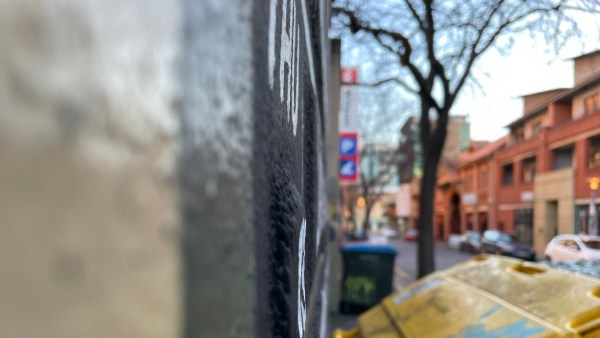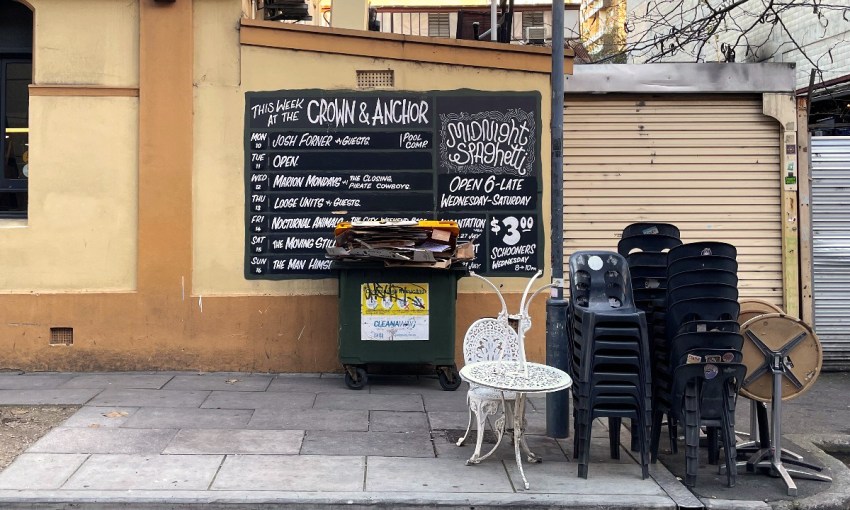To mark CityMag’s 10 year anniversary, the co-founder of the magazine and current Creative Director at kwpx Josh Fanning wonders (sic) through the streets of Adelaide trying to remember what happened.
Whatever happened to… Street Art?
Whatever happened to street artists… activating city laneways?
Whatever happened to… vibrancy?
Whatever happened to…the original Instagram filters like Amaro and those heavy vignettes we put on so many photographs of street art in vibrant laneways?
I don’t know, but things have changed.
This is a weekly column by CityMag founder Josh Fanning exploring how the city has changed – or hasn’t – since he started the city magazine 10 years ago.
Read the other articles in this series here.
For some time now I’ve admired the gig listing the Crown & Anchor paints on its Union Street facade.
If you get close, you can see the black paint protruding from the wall. Layers of history taking up physical space in the present as new gigs are listed and old gigs get painted over. The whole thing – functional as it is – feels like a work of art; an iterative piece of art performed weekly by one of the Cranker’s bar staff.

Squint and you can see the layers of black paint covering over an ever changing artwork each week.
Or maybe I see it as an artwork because I know the bartender painting it is one of Adelaide’s most notorious and still (mostly) anonymous street artists.
When the Academy cinema was demolished to make way for the WhateverItsCalledNow Hotel on Mukata-Hindmarsh Square, this artist’s name (called a tag, or what Twitter calls a ‘handle’) and another’s were revealed in two-storey-high-letters at the top of a building – utterly unreachable by anything other than a crane or scaffold. It was a David Copperfield-esque reveal. In fact, I was unsure whether the piece was painted before the movie theatre was demolished or after.
Either way, the artists’ names were painted bigger than billboards, on property no advertiser could buy, and the point of it all was that no one (other than their friends or rivals) was meant to know who they were or how to find them.
The opposite of advertising.
Why would anyone go to all the trouble of painting a huge artwork, on a highly-visible site, at their own expense (and the landlord’s), so that everyone would see it and no one would know who did it?
The answer – as far as I’ve gathered from speaking with artists at every level from vandal to paid professional is – “Fuck You”.
That’s why.
Fuck You, for asking, and not knowing.
Fuck You, for not doing something yourself.
My apologies for the profanity, but I’m quoting verbatim.
Over many years of writing about this city, the “FU” attitude has been a constant theme among the most interesting, authentic and unique protagonists and contributors to the city’s culture (see previous column).
What’s interesting about the attitude is that it’s a bluff, a defence meant to test whether you really – actually – give a shit about this thing or whether you’re just sticking your beak in and trying to get something out without giving anything back. Are you just trying to get a photo, or are you trying to make something people are going to take a photo of?
Culture is built on reciprocity. You get out what you put in.
And this brings me back to the Cranker. A street artwork in itself.
You can walk by the Cranker and think the patrons out front look cool, or weird, or naïve, or chic. But you can’t go online and buy their look.
You can walk by the Cranker and see who’s on the bill. But you can’t hear their music unless you go in.
You can go into the Cranker and order a beer. But that doesn’t mean you’re going to get service from the bartenders any warmer than the beer they put in front of you. So cold.
You can come back though.
You can pay to enter the band room. You can discover a favourite band. You can buy them a beer after. You can see them again. And again. And over time the Cranker bar staff will learn your name and warm up, a bit. They might smile. And who knows, maybe an infamous street artist will tell you who they are.




